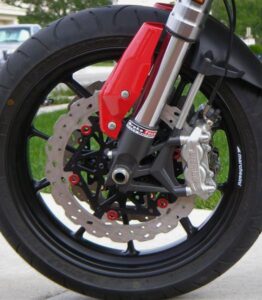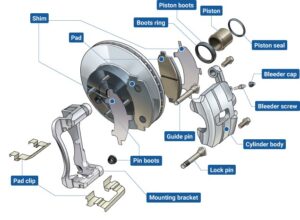
Riding automotive in a country like India is a major problem. On the road, anything can happen, and you may need that stopping power to avoid any disasters. As a result, brakes are an essential component of any vehicle, and they are even more so in motorcycles. With the increased power and speed of modern automotive, consumers are left perplexed when it comes to selecting the proper set of brakes.
Manufacturers have come a long way from ‘placing a foot out,’ to employing metal discs and pads, to enlisting the aid of some great electrical wizardry, all in the sake of bringing a hefty automotive and its rider to a safe and controlled halt in the shortest possible distance.
A disc braking system includes brake pads. Brake pads are pushed together by a calliper against a rotor disc in such systems, thus the name “disc brake.” The friction needed to stop the car is generated by the pads squeezing against the rotor.
Disc brakes have almost no downsides. Disc brakes are usually superior to drum brakes when it comes to braking performance. Although disc brakes are more expensive, the braking performance they provide is well worth the investment.
The brake shoes aren’t supposed to assist you get a faster mile time. They’re made to assist you in stopping your vehicle. In truth, brake shoes are an important component of several braking systems, and they are not the same as brake pads, contrary to popular opinion.
Drum brakes have brake shoes as part of their mechanism. On one side, brake shoes are crescent-shaped components with a rough friction substance. They’re found inside a brake drum. The brake shoes are pulled outward when the brake pedal is pressed, pushing against the inside of the brake drum and slowing the wheel.
Drum brakes and brake shoes are components of an earlier braking system that are less popular in current automotive.
Drum brakes are more economical to manufacture, hence some car types will have them on the rear wheels.
Most modern automobiles have disc brakes with brake pads as part of their braking systems. As previously discussed, some vehicles have disc brakes in the front and drum brakes in the back to assist cut expenses. Disc brakes are nearly typically kept on the front wheels of these cars since they can handle more stopping force when the brakes are applied.

The primary distinction between brake shoes and brake pads is the force direction. Brake shoes push the car outward, whereas brake pads push the car closer together. A calliper squeezes the brake pads together, pressing them on the rotor disc, slowing the wheels and bringing the car to a halt.
A calliper squeezes the brake pads together, pressing them on the rotor disc, slowing the wheels and bringing the car to a halt.
Despite the fact that brake shoes often have bigger amounts of rough-surfaced material to help provide the friction needed to stop the automobile, they typically lack the stopping ability of disc brake pads. When all other factors are equal, disc brakes give far greater stopping power and are much faster than drum brakes, allowing the car to stop faster and over shorter distances.
Because the components are covered by the drum housing, one of the advantages of the drum brake system to the automotive industry is that it has a superior corrosion resistance.
Because of the added protection that the drum provides the housing, drum brake service is necessary less frequently. Due to the greater friction contact surface between the brake shoe and the inside of the drum, they can offer more braking force and have a longer lifespan than a disc brake. Drum brakes are very inexpensive to produce and are found in nearly all automobiles.
